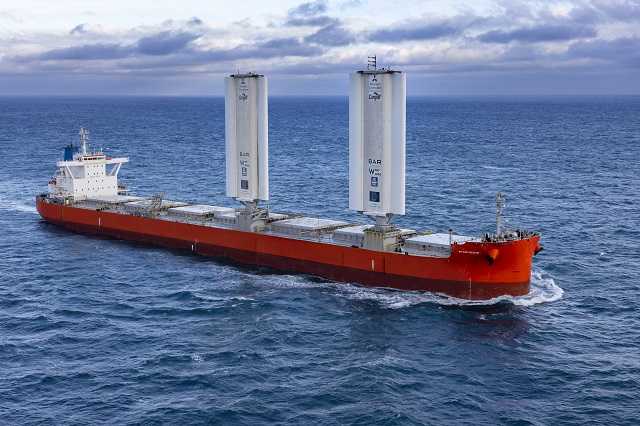GENEVA, Switzerland – Cargill today revealed exciting results of the six-month test period of the Pyxis Ocean, underscoring the potential for the wind assisted propulsion technology in moving the shipping industry toward renewable energy use.
The MC Shipping Kamsarmax vessel retrofitted with two WindWings® -large solid wind sails developed by BAR Technologies – – has achieved performance consistent with what was predicted which is equivalent to an average of 3 tonnes of fuel per day.
“We are encouraged by the results and have learned a great deal about implementing wind assisted propulsion on dry bulk vessels,” said Jan Dieleman, president of Cargill’s Ocean Transportation business. “We could never have done this alone – BAR Technologies and MC Shipping and have been fantastic partners in making the Pyxis Ocean a reality as well as the captain and crew.
We are on the leading edge of change in the shipping industry and believe technologies that harness the wind could be an important, cost-effective way to achieve our decarbonization goals in the short, medium and long-term.”
The Pyxis Ocean hit open waters in August 2023 and during the first six months of testing it has sailed the Indian Ocean, Pacific Ocean, North and South Atlantic, and passed Cape Horn and the Cape of Good Hope. The ship was retrofitted with two WindWings®, which measure 37.5 meters in height and resemble large airplane wings.
The wings are installed vertically to catch the wind and propel the ship forward, allowing the ship’s engine to be turned down so that the ship can travel at the same speed as a conventional ship using less fuel. The wings are controlled by a touch panel on the bridge. A simple traffic light system tells the crew when to raise or lower the sails. Once raised, the operation is fully automated: sensors onboard constantly measure the wind, and the sails self-adjust to the optimal configuration.
Wind assisted propulsion has potential to be a cost-efficient way of supporting the International Maritime Organization’s (IMO) new greenhouse gas strategy. One of the IMOs 2030 targets is to have 5 percent, striving for 10 percent, of energy coming from very low carbon sources by 2030: wind assisted propulsion could be an important way of achieving this.
The early voyages have provided insight on more than just the application of the sails on a vessel, it has also highlighted broader logistical challenges in the global maritime system. Given that every port, terminal, and berth is different, their involvement is critical towards integrating Wind Assisted Propulsion (WAP) technology into the global maritime system on a wider scale.
John Cooper, BAR Technologies CEO added, “The results of the Pyxis Ocean’s first voyage with WindWings® installed clearly demonstrate that wind assisted propulsion can secure significant fuel savings and emissions reduction. For example, in near optimum sailing conditions, during an open sea voyage, the Pyxis Ocean achieved fuel savings of 11 tonnes per day. And while the Pyxis Ocean has two WindWings®, we anticipate the majority of Kamsarmax vessels will carry three wings, further increasing the fuel savings and emissions reductions by a factor of 1.5. With Cargill we are now able to validate our performance predictions and modelling in real-world conditions, it’s an exciting time as we begin to roll out WindWings® production globally.”
“Cargill is creating ways for all WAP vessels – not just the Pyxis Ocean – to operate on global trade routes,” said Dieleman. “So far, we’ve engaged with more than 250 ports to find ways of enabling vessel with large scale WAP to berth. This complexity is where Cargill truly excels, and how we can leverage our unique role in the maritime industry. We are not afraid to be a development partner and invest, share risks with partners, and to make a difference in transforming the industry.”
Cargill will continue the testing and experimenting of operational, technical and commercial aspects of the Pyxis Ocean to incorporate the maximum amount of learning into potential design of future installations before scaling up.
About Cargill Ocean Transportation
Cargill Ocean Transportation is a leading freight-trading organization that charters around 650 vessels worldwide at any one time. Founded in 1956 in Geneva, we benefit from the rich heritage and expert capabilities of Cargill’s global operations in food, agriculture and commodities trading. Our customers, including other companies as well as Cargill’s own internal businesses, are at the center of everything we do. We provide services that combine the latest digital technology with green solutions to make shipping safer and more sustainable.


















